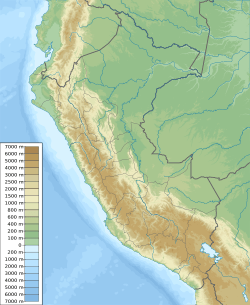Huayuri facts for kids
| Location | Ica Region, Peru |
|---|---|
| Coordinates | 14°32′S 75°16′W / 14.53°S 75.27°W |
| Type | ruins |
| History | |
| Founded | c. 1100 CE |
| Abandoned | c. 1530 CE |
Huayuri, also known as the Lost City of Huayuri, is a big ancient site in Peru. It was a busy place from about 1150 to 1450 CE. This time is called the Late Intermediate Period in Peru's history. Huayuri is found in the desert area near the coast in the Ica Region.
The city likely grew because the weather was wetter back then. It might have been left empty in the 1500s. This could be due to not enough water, fights with the growing Inca Empire, or new diseases from Europe. The city had stone houses and was built in a valley. This location probably helped protect the people living there. People in Huayuri collected rainwater for drinking. They also used it for some farming to feed everyone.
Contents
Where is Huayuri Located?
Huayuri is about 80 kilometers (50 miles) from the Pacific Ocean. It sits about 500 meters (1,640 feet) high. The site is in the Santa Cruz District of Palpa Province. This area is part of the Ica Region in Peru.
The Santa Cruz River is nearby. It flows into the Rio Grande de Nazca River. Other old cultures like the Paracas and Nazca lived in this river area for thousands of years. The people of Huayuri are called the Poroma culture by experts. They came after these earlier desert groups.
What Does Huayuri Look Like?
The ruins of Huayuri stretch along a valley. Two mountain ridges are on either side. The ruins are about 500 meters (1,640 feet) long. The widest part of the city is about 175 meters (574 feet) across. The main ruins cover an area of about 7 hectares (17 acres). The whole site, including the hillsides, is about 20 hectares (49 acres).
Among the ruins, you can see houses. There are also enclosed areas and places to store things. The ruins of Huayuri look down on the Santa Cruz River valley. The river is about 1 kilometer (0.6 miles) away. The river valley is narrow right near Huayuri. But it gets wider a bit upstream. The river is dry for most of the year. This is partly because its water is used for farming.
The stone houses at Huayuri are interesting. People from the coast in Peru usually built with adobe (mud bricks). But people from the highlands built with stone. This suggests the people of Huayuri might have come from the highlands. The city's location in a valley also suggests they wanted a safe place. The valley offered protection, even though the nearby river valley had more water.
Huayuri was also on an old north-south road. This road was part of the Inca road system. It connected the rich farming lands of Ica to Nazca. Experts have found signs that llama groups visited Huayuri. This happened during the time of the Inca Empire. Llamas are better suited for high mountains, not coastal deserts.
How Did Huayuri Get Water?
The desert coasts of southern Peru are very dry. Nazca, a city near Huayuri, gets very little rain each year. The area has almost no plants, except near rivers or where people use irrigation. But experts have found that the weather was less dry when Huayuri was a busy city.
Evidence shows that Huayuri got more rain back then. It might have received 100 to 200 millimeters (4 to 8 inches) of rain each year. This higher rainfall allowed people to collect water. This system is called rainfall harvesting. To collect rainwater, there must be rain. In later centuries, there was almost no rain at Huayuri.
Huayuri had a big system to collect rainfall. It was like the Khadin System used in the Thar Desert in India. The rocky hills around the city collected water. Terraces were built on the hillsides to catch some rain. More water was collected and sent through channels. These channels led downhill to a flat valley area. A low wall or dam blocked the water at the bottom.
The water collected behind the wall. It then soaked into the soil. Crops were planted in this area without extra watering. The soil was good for farming. This is because the water brought new soil and washed away harmful salts. Above and below the wall, stone-lined cisterns collected water. This water seeped through the soil and was used for drinking and daily needs.
Why Was Huayuri Left Empty?
Huayuri had the most people between 1150 CE and 1450 CE. Experts believe that collecting rainwater started around 1260 to 1290 CE. But this system became hard to use in the 1500s. The area became much drier, and rain became very rare.
The Inca Empire started to control Huayuri in the 1470s. The city might still have been lived in when the Spanish arrived in Peru. This was around 1532. New diseases from Europe started spreading in the 1520s. These diseases killed many native people in Peru. This might have also led to the city being left empty.
See also
 In Spanish: Huayuri para niños
In Spanish: Huayuri para niños


